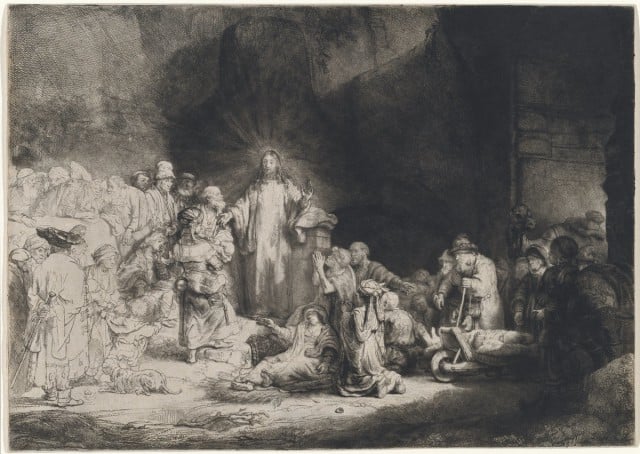Art & Exhibitions
National Gallery Hides Rembrandt Treasure–as it Should
THE DAILY PIC: All museums need to own more works than they can show.

THE DAILY PIC: All museums need to own more works than they can show.

THE DAILY PIC: This is Rembrandt’s so-called Hundred Guilder print, one of the greatest etchings ever made. (Click on my image to see my blow-by-blow analysis of the work.) It is also one of the greatest treasures of the National Gallery of Art in Washington – where it is not on view now, and only rarely is.
That is precisely as things ought to be. On the radio today for the Marketplace Morning Report, I take aim at the constantly reiterated media factoid (stress on the –oid) that museums are in some kind of trouble because they only show five or seven or maybe 10 percent of the works they hold.
This “scandal”, we’re told, might be remedied by selling off some of those “surplus” works, or by expanding our museums to display them. Bumph and harrumph, say I: The vast majority of most museums’ holdings–well over 90 percent, at the National Gallery–are light-sensitive works on paper that would fade away to nothing if they were kept on display, not to mention boring the pants off even the most eager print- or drawing- or photography-lover. (Hands up anyone who wants to see all of Daumier’s thousands of prints at one go.)
I go into all that and more in my Marketplace spot, but there’s one thought that didn’t make it in: We actually wouldn’t want a museum to be whittled down to only its greatest, most showable masterpieces.
That’s because there’s no way to know which works of art will turn out to be true masterpieces, and which will turn out to be the crap that happened to appeal to the idiots who were making the culture’s aesthetic choices in 2015 (yours truly included). That’s why the whole notion of the “timeless masterpiece” is so useless in the first place.
When thinking about museums, the vital model that’s never mentioned is the great library. You wouldn’t expect the Library of Congress or British Library to only hold the 5,000 or so most notable books. Those are, in a sense, the least important works for them to own, because they’re so well known throughout the culture. The really important holdings in any major library, or museum, are the ones that no one is smart enough to look at now, but that will come out of the shadows to transform the lives and culture of our grandkids.
A great museum is the storehouse, the Fort Knox, of our cultural knowledge, and the more it holds, the better – whether we get to see its treasure or not.
For a full survey of past Daily Pics visit blakegopnik.com/archive.